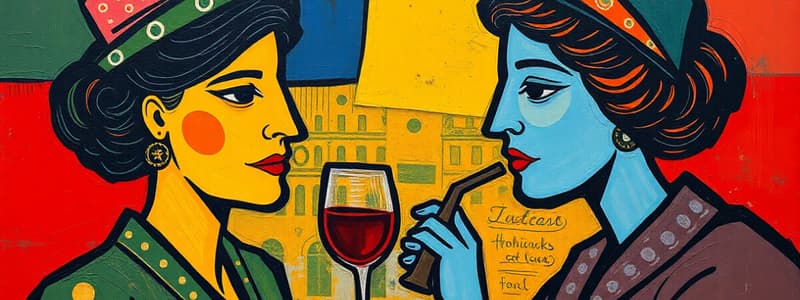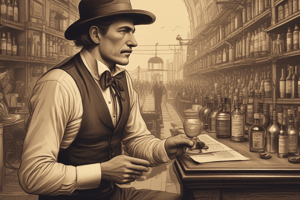Podcast
Questions and Answers
Which action taken by President Roosevelt prior to the attack on Pearl Harbor most directly demonstrated a shift away from American isolationism?
Which action taken by President Roosevelt prior to the attack on Pearl Harbor most directly demonstrated a shift away from American isolationism?
According to the provided text, which of the following was a significant factor contributing to the outbreak of World War II?
According to the provided text, which of the following was a significant factor contributing to the outbreak of World War II?
What was the immediate consequence of the Japanese attack on Pearl Harbor within the United States, as described in the text?
What was the immediate consequence of the Japanese attack on Pearl Harbor within the United States, as described in the text?
How did World War II impact the United States' economy, based on the information provided?
How did World War II impact the United States' economy, based on the information provided?
Signup and view all the answers
Which group of nations is accurately identified as the 'Allied Powers' during World War II according to the text?
Which group of nations is accurately identified as the 'Allied Powers' during World War II according to the text?
Signup and view all the answers
What was the primary goal of the Prohibition Era in the United States?
What was the primary goal of the Prohibition Era in the United States?
Signup and view all the answers
Which piece of legislation officially defined intoxicants during the Prohibition Era?
Which piece of legislation officially defined intoxicants during the Prohibition Era?
Signup and view all the answers
Which groups were prominent supporters of Prohibition?
Which groups were prominent supporters of Prohibition?
Signup and view all the answers
What were speakeasies during the Prohibition Era?
What were speakeasies during the Prohibition Era?
Signup and view all the answers
What was the main focus of women's clubs during the 18th and 19th centuries?
What was the main focus of women's clubs during the 18th and 19th centuries?
Signup and view all the answers
What issues did women's clubs initially concentrate on?
What issues did women's clubs initially concentrate on?
Signup and view all the answers
How did women's clubs contribute to the women's suffrage movement?
How did women's clubs contribute to the women's suffrage movement?
Signup and view all the answers
Which amendment repealed Prohibition in the United States?
Which amendment repealed Prohibition in the United States?
Signup and view all the answers
Which of the following events is considered the official start of the women's rights movement?
Which of the following events is considered the official start of the women's rights movement?
Signup and view all the answers
What was the 'Susan B. Anthony Amendment'?
What was the 'Susan B. Anthony Amendment'?
Signup and view all the answers
Which artistic and intellectual movement originated in Harlem, New York?
Which artistic and intellectual movement originated in Harlem, New York?
Signup and view all the answers
Which of the following artists is NOT associated with the Harlem Renaissance?
Which of the following artists is NOT associated with the Harlem Renaissance?
Signup and view all the answers
What was the primary motivation behind the rise of the Ku Klux Klan in the 1920s?
What was the primary motivation behind the rise of the Ku Klux Klan in the 1920s?
Signup and view all the answers
What were the Palmer Raids?
What were the Palmer Raids?
Signup and view all the answers
What event marked the beginning of the Great Depression?
What event marked the beginning of the Great Depression?
Signup and view all the answers
What was the approximate peak unemployment rate during the Great Depression?
What was the approximate peak unemployment rate during the Great Depression?
Signup and view all the answers
What environmental disaster exacerbated the hardships of rural Americans during the Great Depression?
What environmental disaster exacerbated the hardships of rural Americans during the Great Depression?
Signup and view all the answers
What event ultimately brought an end to the Great Depression in the United States?
What event ultimately brought an end to the Great Depression in the United States?
Signup and view all the answers
What event precipitated the Great Depression?
What event precipitated the Great Depression?
Signup and view all the answers
Which of the following was NOT a goal of Roosevelt's New Deal?
Which of the following was NOT a goal of Roosevelt's New Deal?
Signup and view all the answers
Which New Deal program provided employment through the construction of public infrastructure?
Which New Deal program provided employment through the construction of public infrastructure?
Signup and view all the answers
What was the purpose of the Blue Eagle campaign?
What was the purpose of the Blue Eagle campaign?
Signup and view all the answers
What major event ultimately ended the Great Depression?
What major event ultimately ended the Great Depression?
Signup and view all the answers
Which piece of legislation was passed during Roosevelt's second New Deal?
Which piece of legislation was passed during Roosevelt's second New Deal?
Signup and view all the answers
What was Roosevelt's court-packing plan?
What was Roosevelt's court-packing plan?
Signup and view all the answers
What was the recession of 1937?
What was the recession of 1937?
Signup and view all the answers
Which program provided power to rural areas during the New Deal?
Which program provided power to rural areas during the New Deal?
Signup and view all the answers
What was the purpose of the Neutrality Acts?
What was the purpose of the Neutrality Acts?
Signup and view all the answers
Flashcards
Prohibition Era
Prohibition Era
The period from 1919 to 1933 when alcohol transport and sale were banned in the U.S.
18th Amendment
18th Amendment
A constitutional amendment passed in 1919 that prohibited alcohol in the U.S.
Volstead Act
Volstead Act
The act that enforced Prohibition and defined intoxicants.
Dries vs. Wets
Dries vs. Wets
Signup and view all the flashcards
Speakeasies
Speakeasies
Signup and view all the flashcards
Women's Clubs
Women's Clubs
Signup and view all the flashcards
Anti-Saloon League
Anti-Saloon League
Signup and view all the flashcards
21st Amendment
21st Amendment
Signup and view all the flashcards
Lend-Lease Act
Lend-Lease Act
Signup and view all the flashcards
Pearl Harbor
Pearl Harbor
Signup and view all the flashcards
Executive Order 9066
Executive Order 9066
Signup and view all the flashcards
Atlantic Charter
Atlantic Charter
Signup and view all the flashcards
Neutrality Acts
Neutrality Acts
Signup and view all the flashcards
Great Depression
Great Depression
Signup and view all the flashcards
New Deal
New Deal
Signup and view all the flashcards
Social Security Act
Social Security Act
Signup and view all the flashcards
Works Progress Administration (WPA)
Works Progress Administration (WPA)
Signup and view all the flashcards
Civilian Conservation Corps (CCC)
Civilian Conservation Corps (CCC)
Signup and view all the flashcards
National Recovery Administration (NRA)
National Recovery Administration (NRA)
Signup and view all the flashcards
Second New Deal
Second New Deal
Signup and view all the flashcards
Recession of 1937
Recession of 1937
Signup and view all the flashcards
Franklin D. Roosevelt
Franklin D. Roosevelt
Signup and view all the flashcards
Cash-and-Carry Policy
Cash-and-Carry Policy
Signup and view all the flashcards
Seneca Falls Convention
Seneca Falls Convention
Signup and view all the flashcards
Equal Rights Amendment (ERA)
Equal Rights Amendment (ERA)
Signup and view all the flashcards
Harlem Renaissance
Harlem Renaissance
Signup and view all the flashcards
WEB Du Bois
WEB Du Bois
Signup and view all the flashcards
Ku Klux Klan
Ku Klux Klan
Signup and view all the flashcards
First Red Scare
First Red Scare
Signup and view all the flashcards
Wall Street Crash of 1929
Wall Street Crash of 1929
Signup and view all the flashcards
Dust Bowl
Dust Bowl
Signup and view all the flashcards
Study Notes
Prohibition Era (1919-1933)
- Outlawed alcohol transportation and sale via the 18th Amendment and the Volstead Act.
- Supporters, primarily from the South and West, believed alcohol reduced productivity, discipline, and family stability.
- The Anti-Saloon League and Woman's Christian Temperance Union were key promoters.
- Illegal bars (speakeasies) flourished, leading to increased crime and illegal alcohol production.
- Opposition grew, fueled by rising underage drinking, government regulation issues, and declining revenue.
- The 21st Amendment repealed the 18th Amendment in 1933, ending Prohibition.
Women's Rights Movement
- The 18th and 19th-centuries saw separate spheres for men and women.
- Women's clubs emerged, empowering middle-class women and expanding their social roles.
- At first focusing on education, clubs later addressed temperance, housing, and consumer protection.
- Helped advance the suffrage movement, providing experience and organization.
- The Seneca Falls Convention (1848), marked a pivotal moment in the women's rights movement, solidifying the beginning of the women's rights movement with a Declaration of Sentiments by Elizabeth Cady Stanton and Lucretia Mott.
- Some early feminists opposed the Equal Rights Amendment (ERA) due to concerns about potential harm to women's workforce gains.
- Carrie Chapman Catt organized at the local level to promote women's suffrage.
- The 19th Amendment, granting women the right to vote, was ratified in 1920 (also known as the Susan B. Anthony Amendment).
Harlem Renaissance
- A black intellectual and artistic movement (1920s-1930s) influential in art, literature, and music.
- Artists like Aaron Douglas and Augusta Savage celebrated African heritage.
- Influential figures such as W.E.B. Du Bois aided the movement through organizations like the NAACP and publications.
- Jazz music became popularized by black artists.
- Duke Ellington and Louis Armstrong performed at the Cotton Club (a racially segregated club).
- Combining art forms, such as poetry and music, was common, with Langston Hughes as a key figure.
Rise of the Ku Klux Klan (1920s)
- Nativism and eugenics fueled the KKK's resurgence.
- White Americans feared the impact of immigration on their traditions, religion, and government.
- The Klan represented white supremacy and sought to protect their view through violence and terror against minorities.
- The Klan romanticized the Old South and aimed to uphold traditional white American values.
- Eugenics and immigration restriction were used as tools to maintain white American dominance.
First Red Scare
- Post-World War I and the Bolshevik Revolution, America feared communism.
- Social and political factors like labor unions and xenophobia amplified the fear.
- The Palmer Raids (1919-1920) saw mass arrests of suspected radicals, anarchists, and communists.
- Brutality of the Palmer Raids eventually waned public support, ending the First Red Scare.
- The fear of communism would manifest again in the Cold War.
Wall Street Crash of 1929 and the Great Depression
- Triggered by over-speculation in the stock market, marking the start of the Great Depression.
- The Roaring Twenties saw excessive investment in risky stocks.
- The market's growth stalled and crashed in October 1929, causing severe economic harm.
- Lack of federal safety nets hindered recovery efforts.
- Interventions in 1933 eventually restored some investor confidence in the economy, coinciding with the beginning of the war effort in WWII
- The Great Depression's economic effect, especially on working-class Americans, spanned the 1930s.
Great Depression's Impact
- Unemployment peaked around 25%, leading to soup kitchens, work lines, and shantytowns in urban areas.
- Rural communities, particularly farmers in the Midwest and central US, suffered severely due to the Dust Bowl.
- Labor unrest increased due to economic hardship among those still employed.
- Minority groups, including sharecroppers, Latinos, and Asian Americans, faced greater hardship and discrimination due to job displacement and deportations.
- African Americans suffered job losses, faced violence in the South, and were disenfranchised by methods like the poll tax.
New Deal Programs
- President Franklin D. Roosevelt implemented the New Deal to address the Great Depression.
- The New Deal expanded the role of the federal government in American life.
- Relief programs provided aid to the unemployed.
- Social Security was established to assist the elderly.
- Public works projects like the WPA and CCC employed millions.
- The National Recovery Administration (NRA), aimed to enhance economic recovery, and created jobs while improving treatment of workers and prices.
- Regulations were imposed on the stock market, banks and other industries
- Though effective, many of the programs were not effective in completely ending the Great Depression until the U.S. entered WWII.
Second New Deal
- A shift in focus from first New Deal's aggressive liberalism.
- Crucial legislation like the Social Security Act and the National Labor Relations Act were passed.
- Roosevelt's court-packing plan was rejected by the public, but some Supreme Court justices eventually supported New Deal policies.
- The economy entered a recession in 1937, halting economic progress despite these programs' effectiveness
- The Great Depression would only end completely with the American entrance into WWII.
U.S. Foreign Policy (1930s-1941)
- Roosevelt moved the U.S. from isolationism towards interventionism.
- The Good Neighbor Policy focused on diplomatic ties and trade with Latin America and USSR.
- Neutrality Acts constrained Roosevelt's ability to respond to growing global crises.
- The U.S. partially engaged in international trade while keeping mostly out of the war.
- The "destroyers-for-bases" deal and Lend-Lease Act increased U.S. involvement.
- Roosevelt worked to curtail Japanese economic activity with US sanctions
- The attack on Pearl Harbor led to the U.S. entering WWII.
World War II
- The war began in 1939 with Hitler's invasion of Poland.
- Axis Powers (Germany, Italy, and Japan) and Allied Powers (Britain, Soviet Union, US) formed.
- The war had significant global impact on population (civilian and military).
- The Holocaust was a devastating event of World War II.
Attack on Pearl Harbor
- Japan surprised attacked the United States Naval Base in Pearl Harbor on December 7, 1941.
- The attack aimed to pressure the U.S. to lift economic sanctions against Japan.
- Led to significant loss of U.S. Naval vessels and personnel.
- The U.S. officially entered WWII on December 8, 1941 after Congress declared war on Japan.
Japanese Internment
- Rising anti-Japanese sentiment post-Pearl Harbor resulted in Japanese Americans being forced into internment camps.
- Executive Order 9066 authorized the internments.
- Conditions in internment camps were poor, and many endured significant loss of rights and property during internment.
- Reparations were eventually given, with an apology, compensation, and education initiatives.
Studying That Suits You
Use AI to generate personalized quizzes and flashcards to suit your learning preferences.
Description
Test your knowledge on the Prohibition Era and the Women's Rights Movement. This quiz covers key events, organizations, and societal impacts from the early 20th century. Delve into the significance of the 18th and 19th Amendments and the role of women's clubs in social reforms.




